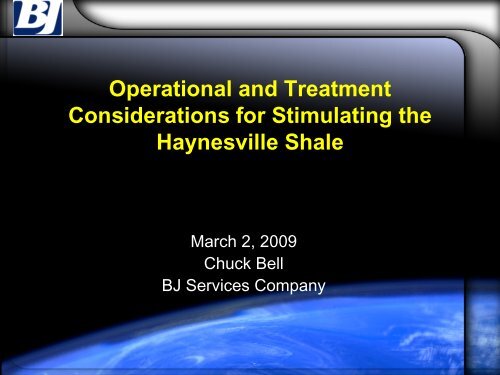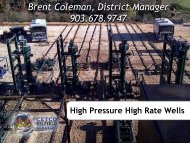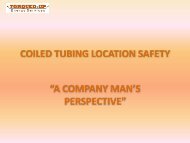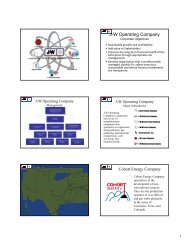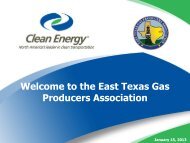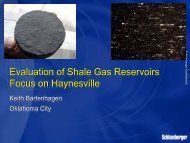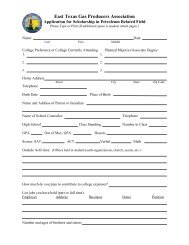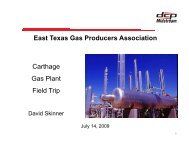Operational and Treatment Considerations for Stimulating the ...
Operational and Treatment Considerations for Stimulating the ...
Operational and Treatment Considerations for Stimulating the ...
You also want an ePaper? Increase the reach of your titles
YUMPU automatically turns print PDFs into web optimized ePapers that Google loves.
<strong>Operational</strong> <strong>and</strong> <strong>Treatment</strong><br />
<strong>Considerations</strong> <strong>for</strong> <strong>Stimulating</strong> <strong>the</strong><br />
Haynesville Shale<br />
March 2, 2009<br />
Chuck Bell<br />
BJ Services Company
Overview<br />
• Field Overview<br />
• Job Quality & Equipment<br />
• Wellbore Configurations<br />
• <strong>Treatment</strong> Designs<br />
• Frac Fluids <strong>and</strong> Proppants<br />
• Future <strong>Treatment</strong>s
Stimulation Jobs by County/Parish<br />
June 1, 2008 – February 18, 2009<br />
Haynesville Depths:<br />
•Harrison @ 10,900’ – 11,400’<br />
•De Soto @ 11,000 - 11,500’<br />
•Bossier/Caddo @ 10,500’-<br />
11,700
Who’s active in <strong>the</strong> Haynesville Shale?<br />
• Cabot Oil & Gas<br />
• Chesapeake<br />
• Comstock<br />
• Devon<br />
• Encana<br />
• Exco<br />
• Forest Oil<br />
• Goodrich<br />
• Petrohawk<br />
• St. Mary’s L<strong>and</strong> &<br />
Exploration Co.<br />
• XTO Energy<br />
• EOG<br />
• Many operators<br />
developing HS<br />
strategies
Shales Compared
Exerpt from Warlick International report “North American<br />
Unconventional Gas Market Report 2008” Edition 2 of 2
FTVLH<br />
14000<br />
12000<br />
10000<br />
8000<br />
6000<br />
4000<br />
2000<br />
0<br />
Depth Ranges<br />
LEWIS<br />
NEW ALBANY<br />
HSVL<br />
WDFDSH<br />
MRCL<br />
MIN_DEPTH (Ft) MAX_DEPTH (Ft)<br />
ANTRIM<br />
OHIO<br />
BARNETT
30<br />
25<br />
20<br />
15<br />
10<br />
5<br />
0<br />
Total Organic Carbon Range<br />
OHIO<br />
ANTRIM<br />
LEWIS<br />
NEW ALBANY<br />
HSVL<br />
WDFDSH<br />
MRCL<br />
FTVLH<br />
MIN_TOC% MAX_TOC%<br />
BARNETT
Thermal Maturity Range<br />
7<br />
6<br />
5<br />
4<br />
3<br />
2<br />
1<br />
0<br />
BARNETT<br />
OHIO<br />
ANTRIM<br />
LEWIS<br />
NEW ALBANY<br />
HSVL<br />
WDFDSH<br />
MRCL<br />
FTVLH<br />
MIN_%Ro<br />
MAX_%Ro<br />
From one Haynesville well, %Ro ranges from 1.5 – 2.5<br />
Potential <strong>for</strong> methane destruction in shales <strong>for</strong> %Ro > 2
FTVLH<br />
16<br />
14<br />
12<br />
10<br />
8<br />
6<br />
4<br />
2<br />
0<br />
Porosity Range<br />
LEWIS<br />
NEW ALBANY<br />
HSVL<br />
WDFDSH<br />
MRCL<br />
MIN_POROSITY MAX_POROSITY<br />
ANTRIM<br />
OHIO<br />
BARNETT
Gas Content Range<br />
500<br />
450<br />
400<br />
350<br />
300<br />
250<br />
200<br />
150<br />
100<br />
50<br />
0<br />
BARNETT<br />
OHIO<br />
ANTRIM<br />
LEWIS<br />
NEW ALBANY<br />
HSVL<br />
WDFDSH<br />
MRCL<br />
FTVLH<br />
MIN_GAS CONTENT (SCF/TON)<br />
MAX_GAS CONTENT (SCF/TON)<br />
Haynesville gas content range is one data point reported by Encana
Reservoir Pressure Gradient Range<br />
0.9 1<br />
0.8<br />
0.7<br />
0.6<br />
0.5<br />
0.4<br />
0.3<br />
0.2<br />
0.1<br />
0<br />
BARNETT<br />
OHIO<br />
ANTRIM<br />
LEWIS<br />
NEW ALBANY<br />
HSVL<br />
WDFDSH<br />
MRCL<br />
FTVLH<br />
MIN_PRESSURE GRADIENT (PSI/FT)<br />
MAX_PRESSURE GRADIENT (PSI/FT)<br />
HSVL source Encana Adcock #1 well (high) <strong>and</strong> Petrohawk EGP #63 press release
350<br />
300<br />
250<br />
200<br />
150<br />
100<br />
50<br />
0<br />
Net Pay Range<br />
BARNETT<br />
OHIO<br />
ANTRIM<br />
LEWIS<br />
NEW ALBANY<br />
HSVL<br />
WDFDSH<br />
MRCL<br />
FTVLH<br />
MIN_NET (Ft) MAX_NET (Ft)<br />
Warning: No guarantee of consistency here!
Haynesville Completion Systems & Staging<br />
• Horizontal laterals typically 4,000 – 5,000 feet<br />
• Cemented 4 1/2” or 5 ½” casing with pumpdown<br />
composite plugs preferred<br />
• 9 – 12 frac stages, one stage per 300 – 500 ft<br />
• Per<strong>for</strong>ated with 3-4 perf sets over 40-60 ft
Wellbore Configurations<br />
• Casing Size<br />
• 5-1/2” 17# P-110 Cemented<br />
• 4-1/2” 15.1# P-110 Cemented<br />
• 5-1/2” 26# Q-125 to 4-1/2” 15.1# P-110 Cemented<br />
• 5-1/2” 23# P-110 Cemented<br />
• 7” 26# P-110 to 5-1/2” 23# P-110 Cemented
Per<strong>for</strong>ation Schemes<br />
• Per<strong>for</strong>ation Schemes<br />
• Vertical 1 stage completion<br />
• 6 intervals/stage, 6 spf, 72 shots<br />
• 5 intervals/stage, 6 spf, 60 shots<br />
• 5 intervals/stage, 2 spf, 50 shots<br />
• 5 intervals/stage 6 spf , 60 shots
Stages & Isolation<br />
• # of stages –<br />
• 200’ Intervals – 40’ between perfs<br />
• 240’ Intervals - 60’ between perfs<br />
• 2’ Intervals – 60’ between perfs<br />
• Method of Zonal Isolation<br />
• Plug <strong>and</strong> Gun<br />
• Flow thru Plug <strong>and</strong> gun<br />
• Pump down rate 150-220 ft/min
<strong>Treatment</strong> Schedule<br />
• Rates & Pressures<br />
• 75-80 bpm @ 7,000 – 8,000 psi<br />
• 50-60 BPM @ 12,000 psi<br />
• 60-70 BPM @ 12,500 psi<br />
• 70-80 BPM @ 12,000 psi<br />
• 80+ BPM @ 12,000 psi<br />
• 80 – 90 bpm @ 10,000 – 12,300 psi<br />
• 80 BPM @ 10,900 psi (avg.)
Questions to be asked…<br />
• What type fluid, <strong>and</strong> why?<br />
• What type proppant,<strong>and</strong> size?<br />
• Rate, which one?<br />
• Prop Volume?<br />
• Fluid Volume?<br />
• Why do we need acid?
Haynesville Frac Fluid<br />
• No consensus on fluid<br />
• SW, hybrid, X-L gels are all in use<br />
• 30 – 35# Borates <strong>and</strong> CMHPG systems<br />
• Hybrid frac using SW / 25# Linear / 25# Borate<br />
fluids<br />
• Increased fluid viscosity seems desirable<br />
from a prop transport st<strong>and</strong>point<br />
• Injection rates in from 50 – 60 bpm up to 85<br />
bpm
What About Proppant?<br />
• Based on rock properties, larger grained proppant will<br />
per<strong>for</strong>m better?<br />
• Which proppant should be utilized?<br />
• Proppant Selections<br />
• 30/50 Interprop<br />
• 100 mesh<br />
• 20/40 ISP<br />
• 40/70 ISP<br />
• 16/30 ISP<br />
• Carbo HydroProp 40/80<br />
• Hexion Prime Plus 40/70<br />
• AcFrac Black Plus 40/70
Haynesville Proppant<br />
• Typical fracs are 8-12 stages with a total of<br />
2-3 MM pounds of proppant<br />
• Texas Average Stages per well is 6-8<br />
• Louisiana Average Stages per well is 6-15<br />
• Designs are focused on 40/70, with some 100<br />
Mesh up front<br />
• Proppants pumped may reflect availability
Proppants Pumped Haynesville Louisiana<br />
• AcFrac Black Plus 20/40 • PR-Black 20/40<br />
• AcFrac Black Plus 40/70 • S<strong>and</strong> White 100 mesh<br />
• Atlas PRC Premium 40/70 • S<strong>and</strong> White 20/40<br />
• Atlas PRC 20/40<br />
• SinterBall Bauxite 30/50<br />
• CARBOHYDROPROP 40/80 • Sinterball 20/40<br />
• Carboprop 16/30<br />
• SinterBlast 50/120 mesh<br />
• Carboprop 20/40<br />
• SinterLite Bauxite 20/40<br />
• Econoprop 20/40<br />
• SinterLite Bauxite 30/50<br />
• Econoprop 30/50<br />
• Tempered HS 20/40<br />
• Interprop 20/40<br />
• Tempered HS 40/70<br />
• Interprop 30/50<br />
• Versaprop 18/40
Proppants Pumped Haynesville Texas<br />
•AcFrac Black Plus 20/40<br />
•S<strong>and</strong>, White, 100 mesh<br />
•AcFrac Black Plus 40/70<br />
•S<strong>and</strong>, White, 20/40<br />
•Atlas PRC Premium, 20/40 •SB Prime 20/40<br />
•Atlas PRC Premium, 40/70 •Silica S<strong>and</strong>, 100 mesh,<br />
•Black Plus 40/70<br />
•SinterBlast, 50/120 mesh<br />
•Ceramax E, 20/40<br />
•Super DC, 20/40<br />
•Ceramax P, 20/40<br />
•Super LC, 20/40<br />
•Econoprop, 20/40<br />
•Super TF, 20/40<br />
•Econoprop, 30/50<br />
•Tempered DC, 16/30<br />
•HyperProp G2, 16/30<br />
•Tempered DC, 20/40<br />
•HyperProp G2, 20/40<br />
•Tempered HS, 20/40<br />
•Interprop, 30/50<br />
•Tempered HS, 40/70<br />
•MagnaProp, 20/40<br />
•Tempered LC, 20/40<br />
•PR-6000, 20/40<br />
•Versaprop, 18/40<br />
•Prime Plus 40/70<br />
•XRT Ceramax V, 18/40
Which Pump Schedule is Best?<br />
• Slickwater?<br />
• Hybrid?<br />
• Reverse Hybrid?<br />
• Typical Cotton Valley?
Slickwater Pump Schedule<br />
• If fracture can be initiated, <strong>the</strong>n prop-sweep style<br />
schedule is per<strong>for</strong>med<br />
• Pad/Prop/Sweep <strong>for</strong> 50% of job<br />
• Prop concentrations 0.25 ppg – 1.00 ppg 100 mesh<br />
• Proppant Ramp<br />
• Prop Concentrations 0.25 ppg – 1.5 ppg<br />
• Lower concentrations of proppant <strong>and</strong> smaller<br />
diameter (effective conductivity)<br />
• Higher rates – 60-80 BPM<br />
• More fluid – 12,000 bbls per stage<br />
• More HHP – 24,000 HHP
Hybrid Pump Schedule<br />
• Starting with Slickwater <strong>and</strong> changing to Linear Gel<br />
• Pad/Prop/Sweep <strong>for</strong> 55% of job<br />
• Prop concentrations 0.25 ppg – 1.00 ppg 100 mesh<br />
• Linear Gel Proppant Ramp <strong>for</strong> 45% of job<br />
• Prop Concentrations 0.25 ppg – 1.5 ppg<br />
• Lower concentrations of proppant <strong>and</strong> smaller<br />
diameter (effective conductivity)<br />
• Higher rates – 60-80 BPM<br />
• More fluid – 12,500 bbls per stage<br />
• More HHP – 24,000 HHP<br />
• Fracture Initiation can be a limitation<br />
• High concentration of proppant in less fluid, but not<br />
significantly
Reverse Hybrid<br />
• Initiate fracture with crosslinked fluid<br />
• 30% of job Volume<br />
• Low volume stages of small mesh high strength ceramic proppant<br />
• Maintain geometry with Slickwater<br />
• 40% of Job Volume<br />
• Pad/Prop/Sweep stages<br />
• High volume of water<br />
• High injection rate<br />
• Place proppant with Linear gel<br />
• 30% of Job Volume<br />
• Proppant ramp 1.5 – 2.0 ppg 40/70 mesh proppant<br />
• Proppant ramp 2.0 – 4.0 ppg 20/40 mesh proppant<br />
• Fracture initiation much less of a problem<br />
• Prop concentrations tend to be higher than Hybrid designs<br />
• Wellbore conductivity increased<br />
• Fluid volume less due to <strong>the</strong> crosslinked pad<br />
• Fluid requirements as low as 8,000 bbls per stage<br />
• High injection rates can be achieved
Typical Cotton Valley(Crosslink)<br />
• Fracture Initiation less of a problem due to<br />
crosslinked fluid throughout job<br />
• Highest propped concentrations achieved<br />
• Proppant stages ramped or stairstepped up to 5 ppg<br />
• Mesh size ramped up from 30/50 or 40/70 <strong>for</strong> 60-65% of<br />
schedule<br />
• Tail in with 20/40 proppant<br />
• Fluid volume requirement is diminished due to <strong>the</strong><br />
crosslink fluid efficiency<br />
• Fluid volumes as low as 6,000 bbls<br />
• High injection rates can be achieved
Additional <strong>Considerations</strong><br />
• First 1 – 4 stages are very hard to initiate<br />
fracture<br />
• Frac Gradient is > 1.0<br />
• Small diameter tubulars<br />
• Higher friction – less effective HHP at <strong>for</strong>mation<br />
• Proppant settling
Look to <strong>the</strong> Future<br />
• Haynesville Shale design still in infancy<br />
• Long term production results have no<br />
baseline <strong>for</strong> design results<br />
• Core analysis will help unravel mystery<br />
• Microseismic will help define fracture shape<br />
<strong>and</strong> effectiveness<br />
• BJ Services Shale Team building extensive<br />
database exclusively <strong>for</strong> Haynesville
Environmental Pressures<br />
• Assume 500 new wells per year<br />
• Frac fluid requirements<br />
• 3,000,000 – 7,500,000 bbls of water<br />
• Methods <strong>for</strong> limiting water exposure?<br />
• Proppant Requirements<br />
• 1.5 billion pounds of Proppant<br />
• Supply lines <strong>for</strong> products <strong>and</strong> chemicals<br />
• Capacity to process increased production
Questions?


